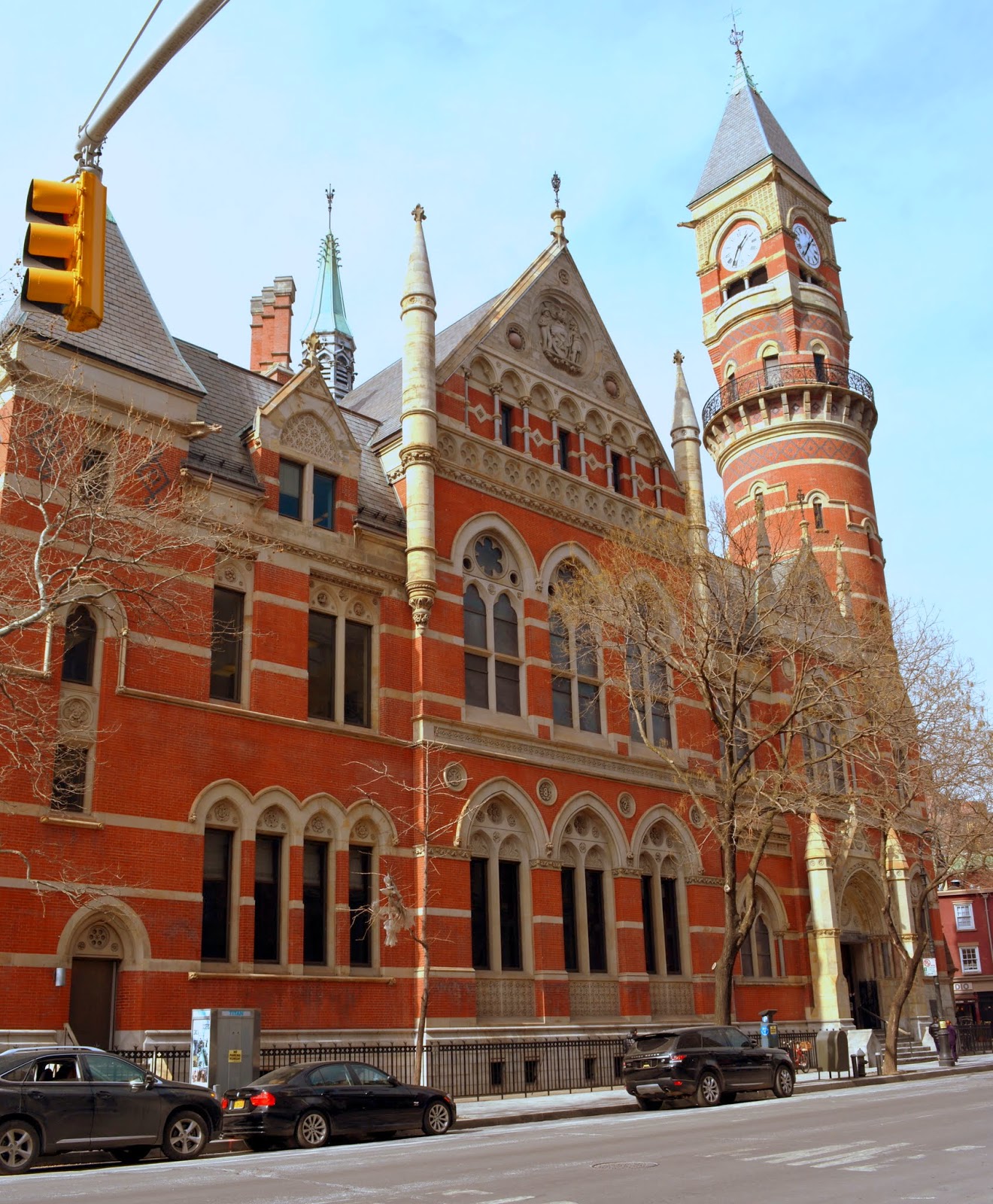The Cathedral Church of St. John the Divine, is the cathedral of the Episcopal Diocese of New York and is located at 1047 Amsterdam Ave, in Manhattan's
Morningside Heights neighborhood. (Please note that all photos in this post will enlarge for easier viewing if clicked on)
To paraphrase its brochure that I collected at the entrance: The Cathedral Church of St. John the Divine is chartered as a house of prayer for all people and a unifying center of intellectual light and leadership. People from many faiths and communities worship together in services held more than 30 times a week. The soup kitchen serves roughly 20,000 meals annually, and it's
Textile Conservation Lab preserves world treasures, concerts, performances, exhibitions, and civic gatherings allow conversations, celebrations, reflection, and remembrance.
The cathedral is the fourth largest Christian church in the world and ties with Liverpool Cathedral for the title of the largest Anglican cathedral and church.
The interior covers 121,000 square feet and spans a length of 601 feet, and a height of 232 feet.
The cathedral 's construction was begun in 1892, and it went under many different style changes during its construction, beginning with a Byzantine-Romanesque Revival style and ending in Gothic Revival style. In December of 2001, it had a massive fire and was closed for repairs until November 2008. It remains somewhat unfinished, with construction, and restoration is a continuing process. The complete history timeline of the cathedral can be seen on its website at
this link.
This was my first visit to the Cathedral, and when I entered the massive size of it took my breath away! There was scaffolding hanging from the ceiling to support an art exhibit--more about that at the end of this post.
Cathedrals seem to make a person's spirit soar because of their grandeur and architectural elegance. Considering that the Cathedral Church of St. John the Divine suffered a giant fire, it was in remarkably good condition.
From west to east run three aisles of bronze floor medallions referred to as the Pilgrims Pavement. The side aisle medallions show the names and crests of key pilgrimage sites, as well as significant sites in Anglican history. The central aisle marks the miracles performed by Jesus from birth through the Feeding of the Multitude...
The rose stained glass window is the largest in the United States, and at forty feet in diameter, it is the third largest in the world! It is made of over ten thousand pieces of glass. At its center is Jesus, surrounded by the New and Old Testament prophets, as well as sixteen angels. Below it is the Lesser Rose Window, shaped like a seven-pointed star.
Each vertical set of stained glass windows is dedicated to one of the fourteen forms of human endeavor, including Labor, Medicine, Education, Military, Arts, and Sport. The ground level windows show a variety of historical and scriptural figures engaged in a particular activity--such a Jesus performing healing miracles.
This pulpit, found on the right, facing the front of the cathedral, is dedicated to the memory of
Horatio Potter, Bishop of New York, 1854-1887.
Standing in the nave, looking back toward the front doors...
...looking forward from the same spot. The size of this cathedral is massive!
The stone pulpit on the left side of the cathedral, with a figure of Saint John the Divine.
Seven chapels are located from the ambulatory behind the choir. These chapels are known as the "Chapels of the Tongues, "and they were designed to represent the seven most prominent ethnic groups to first immigrate to New York City upon the opening of Ellis Island in 1892.
On permanent loan from the Metropolitan Museum of Art, the elegantly carved wooden 15th-century German choir stalls separate the Narthex from the Nave. The Cathedral campus has
six organs. In the photo above you can also see an organist playing the "Great Organ," which was built by the Ernest M Skinner Company in 1910, and rebuilt and enlarged by G. Donald Harrison of Aeolian-Skinner in 1954. After the devastating fire in 2001, the Great Organ was painstakingly restored by Quimby Pipe Organs of Warrensburg, Missouri. The cathedral is known for its "
Great Music in Great Spaces" concerts
The
video above shows a special concert held at the cathedral called "Most Elevating Voices, the Musical Legacy of Andrew Carnegie: A Transatlantic Celebration featuring the voices of the Cathedral's massed choirs, the Oratorio Society of New York, the Manhattan School of Music Chamber Choir, and the famed Great Organ. (Please note there are about three minutes of the video shown before the organ music begins, and 19 minutes before the choirs begin to sing--it is magnificent to hear!)
More photos of some of the architectural and symbolic beauty of the cathedral. Please click on the photo to enlarge.
The Cathedral Church of St. John the Divine is often used as an exhibition space for the arts, and the current exhibit called "
Phoenix"--on display through 2014--was a feat of engineering an ingenuity by contemporary artist
Xu Bing, who culled detritus from constructions sites across the rapidly changing urban landscape of Beijing to transform the objects into this monumental project.
Phoenix is composed of two birds, a male called Feng and a female called Huang. Feng and Huang weigh 12 tons and measure 90-100 feet long, and are suspended in the nave.
Click on the photo collage above to enlarge the photo and read more about the Phoenix.
They were certainly an enthralling sight to see!
One of the "Golden Doors" -- bronze front doors of the Cathedral, seen from the inside. Cast by Barbedienne of Paris, who also cast the Statue of Liberty. Each door is 18 feet high, six feet wide and weighs three tons. The doors have 60 bas relief panels that depict Old and New Testament stories on the exterior side, and flowers and birds and natural imagery on the interior side.
An interesting event that takes place the first Sunday of October at the Cathedral--the "Blessing of the Animals" in honor of St. Francis of Assisi, the patron saint of animals. The church is filled with men, women, and children accompanied by their pets, and assorted guest animals such as llamas, sheep, camels, long-horned steers, turtles, parrots, even bumblebees, etc, are escorted down the church aisle as the ceremony begins. It is a very joyful celebration!
The
video above shows an example of an opening procession of animals, clergy, choir, dancers, and guests. You can also see a video at Time magazine
on this link that shows a little more of the ceremony.
There is also the annual Blessing of the Bicycles, where hundreds of cyclists, including the vulnerable bike messengers of New York City, wheel into the Great Crossing of the church to be blessed. You can read more about this event on this
NPR link.
The Cathedral Church of St. John the Divine is truly a magnificent place to visit, and I hope I've enticed you to want to see it someday and perhaps attend an event there. Come back soon as in a future post I'll show you a very unique and unusual fountain called the "Peace Fountain" that is located in the cathedral's 11.3-acre grounds












































































